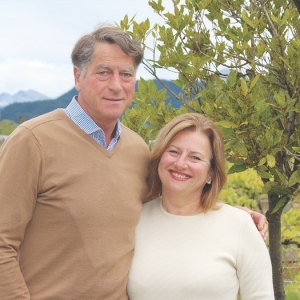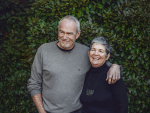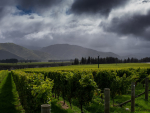Hans and Therese Herzog are no strangers within the wine industry. Hans’ family have been wine makers since 1630, while he himself has over 40 years experience. The Swiss couple who arrived in New Zealand on a visit back in 1981 already owned a vineyard in the Zurich wine country. But Hans was keen to expand outside Switzerland, and find a place where he could concentrate on the Bordeaux blends he had a passion for making.
The visit to New Zealand got him thinking, although Marlborough at that stage had only just begun to develop vineyards and its reputation as a world renowned producer of Sauvignon Blanc was still years away.
Therese says they began seriously contemplating differing regions in the mid 80s. Europe was their first point of call, although it was quickly ruled out by both of them.
“In Europe the continental climate means every vintage is different, you can get maybe two good vintages out of every 10,” she says. “We looked at the Napa, but our pockets weren’t big enough. We looked at Australia, but the climate wasn’t good enough. Then we came to Marlborough and, Hans said, this would be a fantastic place to grow grapes.”
He even identified a small parcel of land in Rapaura that bordered the Wairau River, and had been an apricot, apple and peach orchard since 1921. It was obvious to Hans that this block was perfect for grapes.
“The farmers all told us this was the hottest spot in the whole valley and was the oldest or one of the oldest orchards in Marlborough,” Therese says. “It is protected from the river, and is about one to two degrees warmer than neighbouring vineyards.”
Hans goes on to note that while neighbouring vineyards require frost protection in the form of helicopters in tough years, his little slice of paradise remains protected by the natural surroundings.
The soil is sandy gravel, with pockets of clay in certain places and free draining. With the temperature being slightly higher than other parts of Marlborough, it was perfect for his long-term plan of growing late ripening varieties, the sort that he wouldn’t have been able to contemplate at home in Switzerland.
It wasn’t a fait accompli though as the Herzog’s already had a vineyard in Switzerland and Therese was running a Michelin Star restaurant on their estate. Hans admits it took more than a decade before he convinced Therese that instead of travelling between Switzerland and New Zealand every six months, they should concentrate on New Zealand only.
“It was the end of 1999 when we came here for good,” says Therese. “We thought, the new millennium – that is a good time for a life change.”
Therese says they never intended the small vineyard to be commercially based.
“It was not about a return on investment, but a passion to find out what is possible in the new world. How much better is the new world than the old world?
“So Hans planted everything that wouldn’t grow in our vineyard back home. The first vintage was ‘98, and we built the winery. Hans was over the moon because it was better than ever expected.”
All the plantings are close, with 62,000 vines planted on the 11.5ha, or 5500 vines per hectare. Yields are extremely low, around 2 tonnes per hectare.
Hans who is not only the winemaker, but the hands on viticulturist says he has optimised each and every row. Over the past 14 years, varieties have come and gone, with top grafting common when he has been able to get his hands on new varieties and/or clones.
In his words, he has “planted everything that wouldn’t grow at home.”
But it wasn’t easy to begin with, given there was a dearth of varieties available in New Zealand. His first experiment was with Montepulciano, not a variety he ever intended to grow given it was the cheap, staple wine he and Therese had drunk when they were young. But beggars can’t be choosers
“We had to take what we could get,” Hans says.
Ormond Nurseries had 2500 Montepulciano vines available, so he took them. He said to Therese, “if we can get this ripe, we can get anything ripe”.
And he hasn’t been disappointed, saying it is the one variety that has surprised him the most.
“For me one of the latest ripening, but for me it is the best,” he says. “Since the first vintage I have never been disappointed, never.”
Nebbiolo was one of the next varieties to be planted and that was a real struggle Hans admits.
Planted in 1996, it was 2004 before he got his first crop. Maybe the vines heard him telling Therese, that it wasn’t working and he would have to pull them out and replace with something else. Just in time, the vines fruited and the resulting wine was so good, they have remained an integral part of the vineyard.
Since then Hans has developed somewhat of a vine university, especially since Riversun began importing new clones and varieties into New Zealand in the 2000s. Currently his varietal status sits at 29, although he admits not everything he has planted has been successful.
“We have pulled many out and replaced them,” he says. “A few, some clones, like Pinot Noir Clone 5, I don’t like, so we top grafted. We keep the root system there. Some we pull out four or five rows for a new something more interesting. There is more fine-tuning and will it always be like that, oh yeah.”
The two most challenging varieties for him so far have been are Marsanne and Roussanne.
“In the vineyard they are late ripening and get a bit of powdery easily.”
“It is not your easy grape variety Marsanne, but the wine you make out of it is amazing,” Therese says. “It is like a child, when it is difficult you have to care for it more. But is that a bad thing or a good thing? Do you love it less?”
And when asked if there are other varieties he has in mind for the future, Therese quickly smiles claiming; “only when we are divorced. There will be no more!”
Hans on the other hand says he would love to try Fiano
“I like the wine, it has huge potential.”
We’ll have to watch this space to see if the Herzog stable includes the Italian white variety in the future.
Currently the 29 varieties grown by Herzog are;
Pinot Noir, Pinot Gris, Viognier, Montepulciano, Nebbiolo, Grenache, Cabernet Franc, Merlot, Cabernet Sauvignon, Malbec, Sangiovese, Semillon, Barbera, Tempranillo, Zweigelt, St Laurent, Lagrein, Saperavi, Riesling, Viognier, Marsanne, Roussanne, Verdelho, Arneis, Gruner Veltliner, Chardonnay, Muscat-Ottonel, Vermintino, Gewurztraminer and Sauvignon Blanc.














